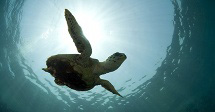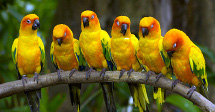Local Watershed Resources
Mauka-to-Makai Watershed Field Trips
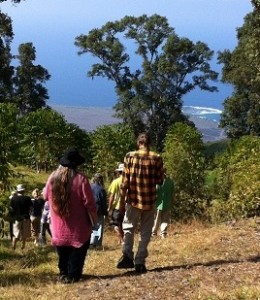
Mountain to Sea – learning the connections
Watershed health can be an indicator of local impacts and broader climate change patterns. How well do you know your watershed boundaries, resources and challenges?
Each year, One Island hosts a watershed awareness field trip that helps us see the inter-connections between human behavior, human choices, and the resources we impact.
Water is a BIG issue on the volcanic island of Hawaii. The state of our soils significantly impacts our access to water, as do our weather patterns and human behaviors. We invite you to join us in learning more about this critical resource and the soil, wildlife, farms, human life and plant systems it influences.
Field trips are a great way to see the watershed connections up front, live, and in action. We’ve been to the up-county in Ka’u at a Nature Conservancy preserve and down to the sea at Whittington Park in 2012, and up above Kealakekua Bay and down to the sea in 2013, making stops along the way to see the impacts for inadequate storm run off planning. In 2014 we took a tour of three water systems in North Kohala featuring water catchment and reuse, hydro power and stream recharge, and agricultural ditch water systems.
Development at higher elevations can send wall of dirt and rocks cascading down slope to destroy buildings, wipe out roads, wash cars off the highway, and send debris into farms along its way to empty contaminants into the sea and onto the fragile coral reefs.
How we dispose of waste, feed our farms and gardens, conserve water, landscape our parcels, site our homes and roads – these are all factors influencing our watershed’s healthy – and its ability to sustain life.
How can we become better Watershed Stewards?
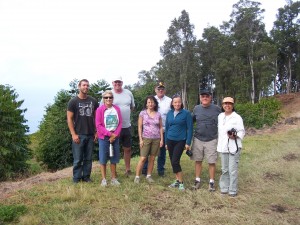
Get Educated, Get Involved
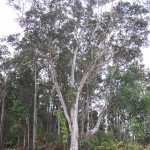
Save our Forests
Solutions include: engineering any grading that changes the terrain, maintaining adequate forest cover and shrubs to retain soil, creating waterways that channel storm water into basins that slow down the force of the water’s movement, building in non-flood zones, using composting toilets or adequate sewage treatment so it does not empty out to sea, growing foods and landscaping organically to prevent pesticide and herbicide chemical getting into our water, and learning to conserve water by using less.
READ Mauka to Makai Field Reports: March 2013
WATCH Water issue movies like Blue Gold
See more links to resources below
More on Water Sustainability Issues in Hawaii
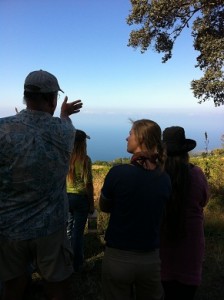
Think Local and Act Locally
Water issues are not just happening ‘somehwere else’. In Hawaii the finite boundaries of each island requires geographically defined water self-sufficiency systems that are reliable, safe, and expandable. On each island there are dozens of micro-climates and varied geologic features that impact the availability,methods, and costs to access safe water.
Availability and Accessibility Issues on the Island of Hawaii
North Kohala is largely dependent on the Kohala Ditch, a conveyance channel that can be quickly altered by earthquakes. Kohala wells periodically run dry and disrupt farming which means less local food.
The eastside of the Big Island has both surface water and underground reservoirs while the west side has no surface water in populated areas and relies solely on wells that tap into natural underground reservoirs called aquifers. It is unknown what the volume of water in these below-surface aquifers in West Hawaii actually is. And even on the wetter eastside of the island, there are periods with no water as rain does not fall evenly through out the year. Harvest water! It is an invaluable resource.
In some areas on the island, salty sea water is contaminating the fresh water aquifers due to human over-consumption of the fresh water which then allows sea water to infiltrate the on-land water table and thereby contaminate what, until recently, were reliable fresh water sources. If over-use cannot be compensated for by renewed rainwater at higher elevations (due to climate or deforestation impacts), it is possible these wells in residential areas will no longer be able to deliver potable water suitable for human consumption. Can we adopt desalinization technologies to ensure adequate fresh water?
Learn about Hawaii Rain Water catchment ideas from University of Hawaii here and order their helpful manual here.
Information on our well systems is being developed by Soil and Water Conservation Districts (KSWCD serves West Hawaii) around the island and USGS provides some information on wells. Department of Land and Natural Resources also provides resources on construction of wells.
Other Threats to Water Quality
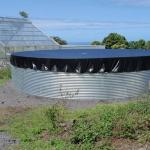 In addition to accessibility and availability issues, the Big Island also faces water threats from earthquake damage, development runoff, and animal contamination – as well as increasingly costly water pumping practices – that impact residential and rural farm settings alike. In addition, human behaviors on land are impacting water quality at sea and directly impacting the sustainability of local fish and sea life populations.
In addition to accessibility and availability issues, the Big Island also faces water threats from earthquake damage, development runoff, and animal contamination – as well as increasingly costly water pumping practices – that impact residential and rural farm settings alike. In addition, human behaviors on land are impacting water quality at sea and directly impacting the sustainability of local fish and sea life populations.
A look at these water challenges includes:
* Agricultural ditches in areas with surface water have been severely damaged by the island’s volatile earthquakes, disrupting water access in areas that have no county supplied water system
* Rapid development of residential, recreational, and commercial complexes has been documented as causing significant runoff pollution from soil, chemical and debris along the shorelines and in the waterways.
* Animal feces contamination – bird or rat, cattle or feral horse – is a serious health threat as it can lead to the deadly Leptospirosis bacteria in water tanks, streams or wells
* For those served by county water, the electric energy cost of pumping water from the underground reservoirs is becoming the highest cost in many residential water bills.
* Impacts of human use of near-shore lands may include contamination from things as invisible as household cleaning and washing practices to the more obvious negative impacts of introducing poisonous pesticide and herbicide chemicals through local agricultural and landscaping practices (that may be at much higher elevations but still will make their way to the sea). If we are to maintain a safe (and edible) sea life population, we will need to develop practices that recognize the inter-relation of the mountain-to-sea connection as a watershed system.
Additional Resources:
Hawaii water systems http://hi.water.usgs.gov/
Catchment water http://www.ctahr.hawaii.edu/oc/freepubs/pdf/rm-12.pdf
State grey water http://health.hawaii.gov/wastewater/files/2013/06/graywater_guidelines.pdf
EPA grey water http://www.epa.gov/region9/waterinfrastructure/training/energy-workshop/docs/2010/ResidentialGraywaterReuseHiMauiOahuKauai.pdf






